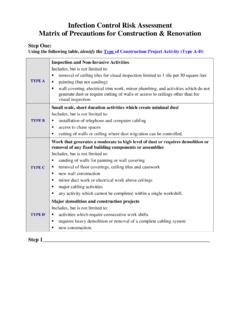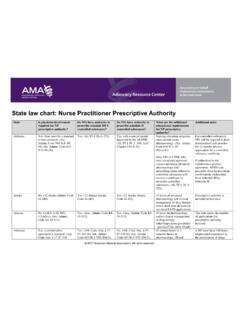Transcription of Nursing Neuro Assessment - PeaceHealth
1 Nursing Neuro Assessment Nursing Neuro Assessment The initial Assessment should be a comprehensive exam covering several critical areas: Level of consciousness and mentation Movement Sensation Cerebellar function Reflexes Cranial nerves This initial exam will establish baseline data with which to compare subsequent Assessment findings. The Single Most Important Assessment Evaluation of level of consciousness (LOC) and mentation are the most important parts of the Neuro exam. A change in either is usually the first clue to a deteriorating condition. The following terms are commonly used to describe a decreased LOC, so it helps to be familiar with them: The Single Most Important Assessment Full consciousness. The patient is alert, attentive, and follows commands.
2 If asleep, he responds promptly to external stimulation and, once awake, remains Lethargy. The patient is drowsy but awakens although not fully to stimulation. He will answer questions and follow commands, but will do so slowly and Obtundation. The patient is difficult to arouse and needs constant stimulation in order to follow a simple command. He may respond verbally with one or two words, but will drift back to sleep between stimulation. Stupor. The patient arouses to vigorous and continuous stimulation;. typically, a painful stimulus is He may moan briefly but does not follow commands. His only response may be an attempt to withdraw from or remove the painful stimulus. Coma. The patient does not respond to continuous or painful stimulation. He does not move except, possibly, reflexively and does not make any verbal sounds.
3 The Single Most Important Assessment Since these and other terms used to categorize LOC. are frequently used imprecisely, you'd be wise to avoid using them in your ,2. Instead, describe how the patient responds to a given stimulus. For example, write: Mr. Smith moans briefly when sternum is gently rubbed, but does not follow commands. 7. Remember that recognizing and describing a change in LOC is more important than appropriately naming The Single Most Important Assessment When assessing LOC, there are several tools you can choose from. With stroke patients, you may want to use the National Institutes of Health (NIH). Stroke Scale. ( ). Typically, though, it is the Glasgow Coma Scale (GCS) that is used in assessing LOC. It's especially useful for evaluating patients during the acute stages of head injury.
4 The Single Most Important Assessment A GCS score is based on three patient responses: eye opening, motor response, and verbal response. The patient receives a score for his best response in each of these areas, and the three scores are added together. The total score will range from 3 to 15; the higher the number, the better. A score of 8 or lower usually indicates ,2. If the patient is alert or awake enough to answer questions, you'll also assess mentation. Determine if he is oriented to person, place, and time by asking questions like: What is your name? Where are you right now? Why are you here? What year is it? Who is the president? The Single Most Important Assessment Pupils are another important component of the Neuro exam. Assessing them is especially important in a patient with impaired LOC.
5 Like a change in LOC, a change in pupil size, shape, or reactivity can indicate increasing intracranial pressure (ICP) from a mass or We'll cover pupils as part of the cranial nerve Assessment . Assessing for Signs of Motor Dysfunction The patient must be awake, willing to cooperate, and able to understand what you are asking him. With the patient in bed, assess motor strength bilaterally. Have the patient: Flex and extend his arm against your hand. Squeeze your fingers. Lift his leg while you press down on his thigh. Hold his leg straight and lift it against gravity. Flex and extend his foot against your hand. Assessing for Signs of Motor Dysfunction Grade each extremity using a motor scale like the one +5 - full ROM, full strength +4 - full ROM, less than normal strength +3 - can raise extremity but not against resistance +2 - can move extremity but not lift it +1 - slight movement 0 - no movement Also, check for arm pronation or drift.
6 Have the patient hold his arms out in front of him with his palms facing the ceiling. If you observe pronation a turning inward of the palm or the arm, or the arm drifts downward, it means the limb is Assessing for Signs of Motor Dysfunction- Unconscious Patient Assess motor response in an unconscious patient by applying a noxious stimulus and observing the patient's response to it. Another approach is central stimulation, such as sternal pressure. Central stimulation produces an overall body response and is more reliable than peripheral stimulation. The reason: In an unconscious patient, peripheral stimulation, such as nail bed pressure, can elicit a reflex response, which is not a true indicator of motor Evaluating Sensation and Cerebellar Function The patient must be able to cooperate with the exam.
7 He'll need to tell you whether he feels the sensation and whether both sides of his body feel it equally. Begin with the feet and move up the body to the face, comparing one side with the other. Assess sensation to light touch using your fingertips or cotton. Test superficial pain sensation with a clean, unused safety pin. Also, test sensation using a dull object. The patient should be able to distinguish sharp from dull. Test proprioception, or position sense, by moving the patient's toes and fingers up or down. Grasp the digit by its sides and have the patient tell you which way it's Evaluating Sensation and Cerebellar Function Test cerebellar function, if indicated. It may not be necessary in a problem-focused exam, and it can't be done if the patient can't or won't follow commands.
8 If the patient is in bed, hold up your finger and have the patient quickly and repeatedly move his finger back and forth from your finger to his nose. Then have him alternately touch his nose with his right and left index fingers. Finally, have him repeat these tasks with his eyes closed. The movements should be precise and Evaluating Sensation and Cerebellar Function To assess the lower extremities, have the patient bend his leg and slide that heel along the opposite shin, from the knee to the ankle. This movement, too, should be accurate, smooth, and without tremors. If the patient is able to stand, you can assess his balance using the Romberg test. Have him stand with his feet together, arms at his sides, and eyes open; he should be able to stand upright with no swaying.
9 If he can do that, have him close his eyes and stand the same way. If he falls or breaks his stance after closing his eyes, the Romberg test is positive, indicating proprioceptive or vestibular Assessing Deep Tendon, Superficial, and Brain Stem Reflexes Deep tendon reflexes include the triceps, biceps, brachioradialis, patellar, and the Achilles tendon. Although deep tendon reflexes aren't routinely assessed, they should be tested in any patient with a spinal cord Deep tendon reflexes are tested with a reflex hammer. Test each of the following, grading them from 0 to 5+, with 0. being no reflex, 2+ being normal, and 5+ being hyperreflexia with clonus (repeated rhythmic contractions). Assessing Deep Tendon, Superficial, and Brain Stem Reflexes Biceps.
10 The patient's arm should be flexed slightly with the palm facing up. Hold the arm with your thumb in the antecubital space over the biceps tendon. Strike your thumb with the hammer; the arm should flex slightly. Triceps. The patient's arm should be flexed 90 degrees. Support the arm and strike it just above the elbow, between the epicondyles; the arm should extend at the elbow. Brachioradialis. The patient's arm should be flexed slightly and resting on the lap with the palm facing down. Strike the outer forearm about two inches above the wrist; the palm should turn upward as the forearm rotates laterally. Patellar. With the patient's legs dangling (if possible), place your hand on one thigh and strike the leg just below the kneecap; the leg should extend at the knee.







